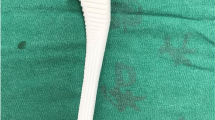Abstract
Press-fit un-cemented hemiarthroplasty used in the treatment of elderly osteoporotic patients with femoral neck fracture requires technical skills in order to avoid iatrogenic complications. This study was performed in order to correlate the complication rate and the grade of the operating surgeon (middle-grade residents as compared to consultants). In this comparative retrospective study, 75 consecutive patients (mean age 80.5 years) were treated for displaced intra-capsular fracture of the neck of the femur with a hydroxy-apatite-coated (HAC) Furlong bipolar hip press-fit hemiarthroplasty. Residents performed the operation without supervision in 50 cases and in the remaining 25 patients, senior colleagues (consultants) performed the operation. The following complications were encountered; ten intra-operative and two postoperative pertrochanteric proximal femoral fractures, two cases of prosthetic loosening, one case of deep wound infection and one case of dislocation of the prosthesis. Re-operation rate was 9% revision (two for loosening, two for early postoperative pertrochanteric fracture and one for infection and one for dislocation). The complications, the intra-operative blood loss and operative time was higher in the hands of junior surgeons. Furlong HAC prosthesis hemiarthoplasty in the elderly was found to be associated with significant technical problems in the hands of junior as compared to the senior colleagues. Inadequate or overzealous reaming of the greater trochanter in order to accommodate the lateral fin of the Furlong press-fit prosthesis in our experience was the main reason for the high incidence of pertrochanteric fractures in this series. Unlike younger patients, osteoporotic patients have a lower threshold for pertochanteric fracture when press-fit prosthesis is used. Training the junior surgeons, the change of design of the press-fit prosthesis and the availability of a wide range of sizes are helpful hints reducing the complication rate. We suggest changing the current design when used in elderly.
Résumé
Le traitement des fractures du col de fémurs ostéoporotiques chez des patients âgés par hémiarthroplastie press-fit non cimentée nécessite des qualifications techniques pour éviter les complications iatrogènes. La présente étude a été conduite dans le but de comparer le taux de complications et le grade du chirurgien (résidents en milieu de formation par rapport aux consultants séniors). Dans cette série comparative rétrospective consécutive, 75 patients (âge moyen 80,5 ans) avaient été opérés pour des fractures déplacées intra-capsulaires du col fémoral avec une prothèse press-fit bipolaire de FURLONG recouverte d’hydroxyapatite. Des résidents ont réalisé cette intervention sans contrôle par un sénior dans 50 cas et l’intervention avait été réalisée par un sénior consultant pour les 25 autres cas. Les complications suivantes ont été notées: dix fractures per-trochantériennes proximales peropératoires et deux postopératoires, deux cas de descellement prothétique et un cas d’infection profonde, un cas de luxation de la prothèse. Le taux de réintervention était de 9 % (trois pour descellement, deux pour fracture péri-trochantérienne précoce, une pour infection et une pour luxation). Les complications, la déperdition sanguine peropératoire et la durée de l’intervention étaient plus importantes dans les mains des jeunes opérateurs. L’hémiarthroplastie de FURLONG chez les patients âgés est grevée de complications significatives entre les mains de jeunes chirurgiens si l’on compare avec une série réalisée par des chirurgiens séniors. Un alésage inadapté ou trop généreux du grand trochanter afin d’adapter l’os à l’aileron latéral de la prothèse de FURLONG a été pour nous la cause principale du taux important de fractures dans cette série. Le seuil de fractures péri-trochantériennes chez les patients ostéoporotiques est plus bas que chez les patients plus jeunes, lorsque l’on utilise une prothèse press-fit. L’entraînement des jeunes chirurgiens, le changement du dessin de la prothèse press-fit et la disponibilité d’une gamme plus large de différentes tailles sont les conseils les plus utiles pour réduire le taux de complications. Nous suggérons de changer le dessin de la prothèse pour patients âgés.

Similar content being viewed by others
References
Bowen JL (1998) Adapting residency training. Training adaptable residents. West J Med 168:371–377
Callaghan JJ, Heekin RD, Savory CG (1992) Evaluation of the learning curve associated with uncemented primary porous-coated anatomic total hip arthroplasty. Clin Orthop 282:132–144
Evarts CM (1997) Critical ingredients of an orthopaedic career. J Bone Joint Surg 79-A:479–804
Follaci F, Charnley J (1969) A comparison of femoral head prosthesis with and without cement. Clin Orthop 62:15–18
Hardy DC, Frayssinet P, Bonel G (1994) Two-year outcome of hydroxy-apatite coated prosthesis. Two femoral prosthesis retrieved at autopsy. Acta Orthop Scand 65:253–258
Lennox IAC, McLaughlan J (1993) Comparing mortality and morbidity of cemented and uncemented hemiarthroplasties. Injury 24:185–188
Lintner F, Bohm G, Huber M, Scholz R (1994) Histology of tissue adjacent to an HAC-femoral prosthesis. J Bone Joint Surg 76:824–830
Livesly PJ, Srivastva VM, Needof M, Prince HG, Moulton AM (1993) Use of hydroxy apatite coated hemi-arthroplasty in the management of sub-capital fractures of the femur. Injury 24:236–240
Lo WH, Chen WM, Haung CK, Chen TS, Chiu FY, Chen CM (1994) Bateman bipolar hemiarthroplasty for displaced intracapsular femoral neck fractures, uncemented versus cemented. Clin Orthop 302:75–82
Murihead-Allwood W, Hutton P (1983) A comparative study of cemented and uncemented Thompson prosthesis. An abstract. J Bone Joint Surg [Br] 65:12–16
Nidatasaji P, Bhouati V, Patankumjorn D (1995) Austin Moore hip prosthesis replacement in Ratchaburi Hospital. J Med Assoc Thai 78:469–473
Osborn JF (1987) The biological behaviour of hydroxy apatite coating on titanium stem of a hip prosthesis, the first histological evaluation of human autopsy specimens. Biomed Tech S17:7–8
Thompson FR (1954) Two and a one-half years experience with a vitallium intramedullary hip prosthesis. J Bone Joint Surg [Am] 36:489–491
Acknowledgments
We would like to thank the orthopaedic department at King’s Mill Hospital and Mr J. Hambidge, P.J. Livesly, A. Moulton, and H. Prince for permitting us to use the clinical data for this study.
Author information
Authors and Affiliations
Corresponding author
Rights and permissions
About this article
Cite this article
Faraj, A.A., Drakau, N.N. Press-fit hemiarthroplasty for elderly with femoral neck fracture: high complication rates in operations performed by younger surgeons. Eur J Orthop Surg Traumatol 17, 267–271 (2007). https://doi.org/10.1007/s00590-006-0162-4
Received:
Accepted:
Published:
Issue Date:
DOI: https://doi.org/10.1007/s00590-006-0162-4




